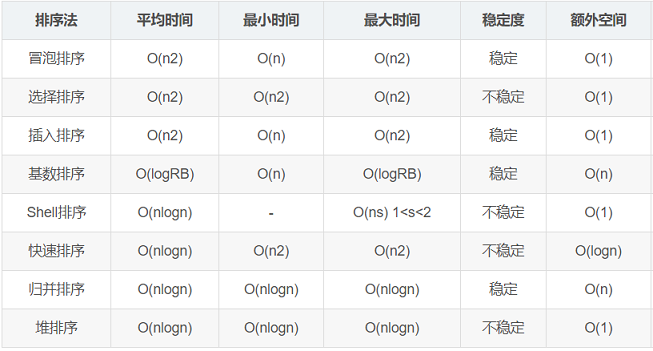Java中几种排序算法
1、冒泡排序算法
通过多次比较(相邻两个数)和交换来实现排序
public class bubble {public static void bubbleSort(int[] a) {int temp;for (int i = 1; i < a.length; i++) {//将相邻两个数进行比较,较大的数往后冒泡for (int j = 0; j < a.length - i; j++) {if (a[j] > a[j + 1]) {//交换相邻两个数temp=a[j];a[j]=a[j+1];a[j+1]=temp;}}}}public static void main(String[] args) {int[] mao= { 213,123,342,543,12,67,98,320,421,4,15,54,27,34,17};System.out.print("排序前的数组为:\n"); //输出排序前的数组for(int i=0;i<mao.length;i++){System.out.print(mao[i]+" ");}System.out.print("\n");bubbleSort(mao); //排序操作System.out.print("排序后的数组为:\n");for(int i=0;i<mao.length;i++){System.out.print(mao[i]+" "); //输出排序后的数组}System.out.print("\n");}}
2、直接插入排序
通过对未排序的数据执行逐个插入至合适的位置而完成排序
public class straight{public static void straightInsertion(int[] arr) {int current;//要插入的数//从1开始第一次一个数不需要排序for (int i = 1; i < arr.length; i++) {current = arr[i];int j = i - 1; //序列元素个数//从后往前循环,将大于当前插入数的向后移动while (j >= 0 && arr[j] > current) {arr[j + 1] = arr[j]; //元素向后移动j--;}arr[j + 1] = current; //找到位置,插入当前元素}}}
3、快速选择排序
通过多次比较和交换来实现排序。首先设定一个分界值,将所有数值与分界值比较,左小右大,比较和交换数据值进而完成排序
public class quick{static void quickSort(int[] arr,int left,int right) {int f,t,rtemp,ltemp;ltemp=left;rtemp=right;f=arr[(left+right)/2]; //分界值while(ltemp<rtemp){while(arr[ltemp]<f){++ltemp;}while(arr[rtemp]>f){--rtemp;}if(ltemp<=rtemp){t=arr[ltemp];arr[ltemp]=arr[rtemp];arr[rtemp]=t;rtemp--;ltemp++;}}if(left<rtemp){quickSort(arr,left,ltemp-1); //递归调用}if(ltemp<right){quickSort(arr,rtemp+1,right); //递归调用}}}
4、希尔排序,又称Shell排序或缩小增量排序
(1)将有n个元素的数组分成n/2个数字序列,第1个数据和第n/2+1个数据为一对。
(2)一次循环使每一个序列对排好顺序。
(3)然后,再变为n/4个序列,再次排序。
(4)不断重复上述过程,随着序列减少最后变为一个,也就完成了整个排序。
public class shell{static void shellSort(int[] a){int h,temp,x=0;for(int r=a.length/2;r>=1;r/= 2) //划组排序{for(int i=r;i<a.length;i++){temp=a[i];int j=i-r;while(j>=0 && temp<a[j]){a[j+r]=a[j];j-=r;}a[j+r]=temp;}x++;}}}
5、堆排序
构造堆结构、堆排序输出来实现排序
public class pratice {public static void heapSort(int a[],int n){int i,j,h,k;int t;for(i=n/2-1;i>=0;i--) //将a[0,n-1]建成大根堆{while(2*i+1<n) //第i个结点有右子树{j=2*i+1 ;if((j+1)<n){if(a[j]<a[j+1]) //右左子树小于右子树,则需要比较右子树j++; //序号增加1,指向右子树}if(a[i]<a[j]) //比较i与j为序号的数据{t=a[i]; //交换数据a[i]=a[j];a[j]=t;i=j ; //堆被破坏,需要重新调整}else //比较左右子结点均大则堆未破坏,不再需要调整{break;}}}//输出构成的堆System.out.print("原数据构成的堆:");for(h=0;h<n;h++){System.out.print(" "+a[h]); //输出}System.out.print("\n");for(i=n-1;i>0;i--){t=a[0]; //与第i个记录交换a[0] =a[i];a[i] =t;k=0;while(2*k+1<i) //第i个结点有右子树{j=2*k+1 ;if((j+1)<i){if(a[j]<a[j+1]) //右左子树小于右子树,则需要比较右子树{j++; //序号增加1,指向右子树}}if(a[k]<a[j]) //比较i与j为序号的数据{t=a[k]; //交换数据a[k]=a[j];a[j]=t;k=j ; //堆被破坏,需要重新调整}else //比较左右子结点均大则堆未破坏,不再需要调整{break;}}}}}
6、归并排序
两两合并,进行比较、交换来实现排序
public class marge {public static void mergeOne(int a[],int b[],int n,int len){ //完成一遍合并的函数int i,j,k,s,e;s=0;while(s+len<n){e=s+2*len-1;if(e>=n) //最后一段可能少于len个结点{e=n-1;}//相邻有序段合并k=s;i=s;j=s+len;while(i<s+len && j<=e) //如果两个有序表都未结束时,循环比较{if(a[i]<=a[j]) //如果较小的元素复制到数组b中{b[k++]=a[i++];}else{b[k++]=a[j++];}}while(i<s+len) //未合并的部分复制到数组b中{b[k++]=a[i++];}while(j<=e){b[k++]=a[j++]; //未合并的部分复制到数组b中}s=e+1; //下一对有序段中左段的开始下标}if(s<n) //将剩余的一个有序段从数组A中复制到数组b中{for(;s<n;s++){b[s]=a[s];}}}static void mergeSort(int a[],int n) //合并排序{int h,count,len,f;count=0; //排序步骤len=1; //有序序列的长度f=0; //变量f作标志int[] p=new int[n];while(len<n){if(f==1) //交替在A和P之间合并{mergeOne(p,a,n,len); //p合并到a}else{mergeOne(a,p,n,len); //a合并到p}len=len*2; //增加有序序列长度f=1-f; //使f值在0和1之间切换count++;System.out.printf("第"+count+"步排序结果:"); //输出每步排序的结果for(h=0;h<SIZE;h++){System.out.printf(" "+a[h]); //输出}System.out.print("\n");}if(f==1) //如果进行了排序{for(h=0;h<n;h++) //将内存p中的数据复制回数组a{a[h]=p[h];}}}}
拓展:几种算法的比较



































还没有评论,来说两句吧...